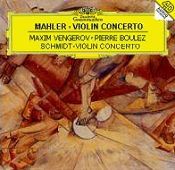Franz SCHMIDT: Concierto para violín.
Maxim Vengerov; Orquesta Sinfónica de Chicago; Pierre Boulez.
Deutsche Grammophon 566612-2
2 CD [94'57"]

|
Gustav MAHLER: Concierto para violín en fa sostenido menor Franz SCHMIDT: Concierto para violín. Maxim Vengerov; Orquesta Sinfónica de Chicago; Pierre Boulez. Deutsche Grammophon 566612-2 2 CD [94'57"] |
 |
| Derek Lim, Flying Inkpot |
Following their recent release of Bartók's Violin Concerto No. 2, in a sparkling rendition, the duo of Vengerov and Boulez once again surprise the musical world with two premiere recordings (the Mahler has yet to be played in public performance). How does one greet a masterpiece composed by one of the great symphonists of his time? It was once thought that Mahler had never composed a concerto, save his concertino parts in his symphonies (3-I Trombone, 4-II violin, 5-III horn, etc.), this recent score uncovered and held in top secret, so the programme notes by Deryck Cook say, in the March of last year, in Wilhelm Mengelberg's apartment. It is well-known, of course, that there were discoveries of several early symphonies, apparently, and the first movement of Mahler's cantata Das Klagende Lied was also hidden from public view until after Mahler's death, but the discovery of this totally unpublished, unfinished score is on a scale akin to the discovery of cold fusion. For that is what the music is unfinished. Deryck Cook in recent years has pieced together the monumental Violin Concerto in six movements. On the manuscript, fascimiles of which are included in this lavishly decorated (and aptly, one might say) set, are words, among which on the first movement says «gewidmet zum meiner lieben Frau Almschi» (dedicated to my wife Alma) and «Des Himmels Lächeln».
Here's a taste (and bare description) of what the first movement is like:
The first movement starts with a Mahlerian theme akin to that of the Tenth Symphony's Adagio (with which it shares a key: F-sharp minor), and is not virtuostic in the normal sense. I would rank it with the Beethoven violin concerto for instance. This is quickly taken up by the orchestra, which briskly brings in the second theme (Nicht eilen), which once again brings the solo violin back in (zögernd, wie im Winterschnee), the two themes then intertwine, tension between the solo and the orchestra rising, with the orchestra trying to establish an E-flat major this time, while the soloist's chords belong to the distant D-minor. The second trio finds the two «agreeing» on E major, which is then undermined by the theme on bassoons, which is in F-sharp minor. The ensuing pathos is truely unbearable, with the soloist (after five minutes [!]) relenting and falling back into F-sharp minor. The movement ends piannisimo.
The second movement and fourth movement are scherzos which frame an inner, slow movement, the fifth and sixth movements are attaca after the fourth movement. Mahler's musical language remains eminently recognizable, and his craftmanship, and orchestration is second to none. Of course one must bear in mind that some of this orchestration is the property of Deryck Cook, but he is an orchestrator deeply steeped in the Mahlerian style. For example, in the third, slow movement, which is incomplete, Cook adds in a piccolo to double the lines of the trombones, which adds a special piquant flavour to the moment.
The concerto, reflecting Mahler's later style is largely dark, but hardly pessimistic - though it is said that the concerto is in F-sharp minor (the key of the first movement) it ends in blazing C major (like his Seventh Symphony) in a scintillating cadenza in strict time before the coda. It is long �90 minutes� preemting the Elgar's own prodigious length, and it is highly unlikely that any soloist would dare to take up the challenge in concert. This new recording affords us the opportunity to listen to a late masterpiece by one of the great Masters.
The 20-minute Franz Schmidt Violin concerto in D is a Post-romantic piece with a Classical throwback �hence expect contrabassoons throwing parts among themselves� really quite clever orchestration actually! But let me not distract you from the original, and more important find � the Mahler. Needless to say, Vengerov (right) is more than up to the task, and Pierre Boulez gives a very analytical approach to the score, which by the way has lots of atonalism and a sprinkle of dodecaphonic contrapuntalism � just his cup of tea.
|
|